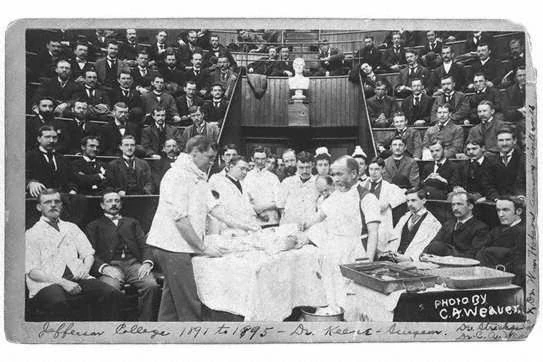
History of the Operating Room from the 16th century until now
We always look at the operating room with astonishment, curiosity, and some fear due to the awe-inspiring nature of this place. However, the real terror and fear lie in the fact that the operating room used to be an actual theater for surgery in ancient Britain!
A theater in the truest sense, with seating and an audience, where the patient would be placed on a stage without anesthesia, and the surgery would be performed in front of the spectators. The cries of pain from the patient and the voices of the suffering audience were the backdrop for these procedures.

In the 16th century, surgeons would perform anatomical dissections in theaters in front of medical students to learn anatomy practically. It then evolved into performing surgeries on live, unanesthetized patients in front of audiences consisting of the general public, enthusiasts, and other physicians.
Due to the high demand to witness surgical theaters, tickets were sold at a nominal price after prior announcement.
In the 19th century, medical lecture halls became the venues where surgeons would showcase their surgeries to an audience of up to 450 spectators in the auditorium seating.
Adding to the horror, there was often a struggle between unwilling patients and eager volunteers for the surgical procedures. The main surgeon had to demonstrate courage and swift action. A companion stood beside the surgeon, recording the time with a stopwatch in hand, while blood was collected in a box filled with sawdust, and wounds were left without sutures!
The persona of the surgeon always reflected a desire to perform the art of surgery in front of an audience. Surgeons were expected to have the "eagle's eye, lion's heart, lady's hand, and the brilliance of a skilled actor," as described by Scottish surgeon James H. Ferguson.

In ancient times, operating rooms were seats of excitement and tragedy. The cries of patients during surgery drove the spectators into a frenzy. However, the development of anesthesia in the 1840s led to a reduction in screaming during surgical procedures, resulting in a much greater interest in surgeries.
As the number of spectators increased, surgeons moved to larger theaters to accommodate the crowds. Then, in the 1870s and 1880s, surgical displays were developed as a form of entertainment that attracted a significant audience.
Some hospitals went as far as renovating their theaters to attract wealthier audiences to witness their surgical performances, aiming to gain reputation and financial gain.

The situation did not remain the same; it instead sparked anger among many scholars who warned against conducting operations in this manner, as over 50% of patients were dying due to lack of sterilization.
Surgeons, scientists, and physicians launched a counterrevolution against the unsanitary practices. They refused to accept the continuation of these "slaughters," and it took a long time to establish the sanctity of the operating room.

Those days have vanished, and over the years, technologies have evolved to shape the operating room into its current form. The nursing team now rigorously performs sterilization and disinfection. Ventilation and air conditioning are carefully regulated to ensure proper airflow, and humidity levels are maintained at a minimum of 50%.
In addition to sterilizing the room, doctors and the medical team sanitize their hands with special soap and high-alcohol-based disinfectants. They wear fully sterilized attire, and the process of hand sanitization for the doctor takes approximately 5 minutes to ensure the elimination of germs before entering the operating room.

ChatGPT
Operating rooms are typically kept cool to minimize the presence of harmful bacteria, and the lighting is bright with careful attention to avoiding shadows.
All instruments used in the procedure are sterilized and placed on a stainless steel surface. Adjacent to the operating bed is the largest device in the room, the anesthesia machine. It consists of numerous buttons and components that precisely and carefully control the dosage of anesthetic gases.
The anesthesia machine helps maintain proper respiration for the patient during surgery and ensures sufficient oxygen flow to the body's organs. The respiratory device is adjusted by specialized anesthesiologists to ensure the patient receives anesthesia safely and effectively during the surgical procedure. In this way, the anesthesiologist is the hero of the operating room and the primary responsible for the patient's safety.

In our present era, medical technologies have advanced tremendously, making operating rooms sophisticated and complete, with the margin of error nearly negligible when skilled physicians and teams utilize these technologies.
Despite the disappearance of the "surgical theater" in its old sense, the British still use the term "operation theater" instead of "operating room."
If we contemplate this name apart from its origins, it is a marvelous expression. The room itself is the theater, the doctors are the heroes, the medical team are the supporting cast, and the surgical procedure is the play that must be successfully completed, no matter how challenging. The curtain is drawn after ensuring the successful completion of the "play."
How the operating room used to be a theater for surgery, with an audience, and how it has evolved to our present day!
